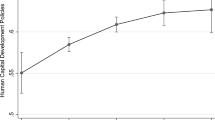Abstract
This study examines the application and acquisition process of individuals completing a principal licensure program to obtain school administrative positions over a period of five years. While relatively low compensation and high-pressure accountability demands were viewed as deterrents by those deciding not to seek principalships, the majority of the study participants actively sought and obtained schoool administrative positions. Gender differences were examined in the areas ofapplying for positions, interviewing, and number of job offers. Reasons for not applying for principal and assistant principal positions were also examined.
Similar content being viewed by others
References
Bowles, B., King, D., & Crow, G. (2000, April). Viable principal candidates: Superintendents' perspective. Paper presented at the Annual Meeting of the American Educational Research Association, New Orleans, LA.
Brighouse, T., & Woods, D. (1999). How to improve your school? London: Routledge.
Bryk, A., Sebring, P., Kerbow, D., Rollow, S., & Easton, J. (1998). Charting Chicago School Reform. Boulder, CO: Westview Press.
Carrigan, J., Brown, C., & Jenkins, K. (1999, March). Principals' salaries: Incentives or deterrents to professional advancement. Paper presented at the Annual Meeting of the American Education Finance Association, Seattle, WA.
Cusick, P. A. (2003). A Study of Michigan's School Principal Shortage. Policy Report No. 12, January 2003. Lansing, MI: Michigan State University.
Day, C., Harris, A., Hadfield, M., Toley, H., & Beresford, J. (2000). Leading schools in times of change. Buckingham, England: Open University Press.
De Angelis, K. J. (2003). In the pipeline: The early career paths of administrative certificate holders in Illinois. Edwardsville, IL: Illinois Education Research Council.
Donaldson, G. (2001). Cultivating leadership in schools: People, purpose, and practice. New York: Teachers College Press.
Educational Research Service. (1998). Is there a shortage of qualified candidates for opening in the principalship? An exploratory study. Reston, VA: National Association of Elementary Principals.
Education Research Service, National Association of Elementary School Principals, National Association of Secondary School Principals. (2000). The principal, keystone of a high-achieving school: Attracting and keeping the leaders we need. Arlington, VA.
Elmore, R. (2000). Building a new structure for school leadership. Washington, DC: The Albert Shanker Institute.
Farkas, S., Johnson, J., Duffett, A., Foleno, T., & Foley, P. (2001). Trying to stay ahead of the game: Superintendents and principals talk about school leadership. New York: Public Agenda.
Fullan, M. (1997). What's Worth Fighting for in the Principalship? New York: Teachers College Press.
Fullan, M. (2001). The New Meaning of Educational Change, 3rd edn. New York: Teachers College Press.
Galvin, P., & Sperry, D. (1996). Educational leadership in Utah public schools: Results of the Utahschool administrator survey. University of Utah: Utah Consortium for Educational Leaders.
Gates, K. M., Ringel, J. S., Santibanex, L., Ross, K. E., & Chung, C. H. (2003). Who is Leading our Schools? An Overview of School Administrators and Their Careers. Santa Monica, CA: RAND.
Hite, S. J., Krueger, J., & Basom, M. R. (1994). Successful and unsuccessful candidates for public school administrative positions. Journal of School Leadership, 4(5), 557–576.
Institute for Educational Leadership. (2000). Reinventing the principalship. Washington, D.C.: Institute for Educational Leadership.
Lortie, D., Crow, G., & Prolman, S. (1983). The Elementary School Principal in Suburbia: An Occupational and Organizational Study. Washington, D.C.: National Institute of Education.
Leithwood, K., & Jantzi, D. (1999). The relative effects of principal and teacher sources of leadership on student engagement with school. Educational Administration Quarterly, 35(Suppl.), 679–706.
Logan, J. P., & Scollay, S. (1999). The gender equity role of educational administration programs: Where are we? Where do we want to go? Journal of School Leadership, 9, 97–124.
Malone, B. G., & Caddell, T. A. (2000). A crisis in leadership: Where are tomorrow's principals? The Clearing House, 73(3), 162–164.
McAdams, R. (1998). Who'll run the schools? The coming administrator shortage. The American School Board Journal, 8, 37–39.
McLaughlin, M., & Talbert, J. (2001). Professional Communities and the Work of High School Teaching. Chicago: University of Chicago Press.
Mulhall, P., Hartter, S., & Camp, D. (2003). Illinois principals: Instructional Leaders or Endangered Species? Executive summary. Champaign, IL: Institute of Government Public Affairs.
Murphy, J. (1994). Transformational change and the evolving role of the principal: Early empirical evidence. In J. Murphy, & K. S. Louis (Eds.), Reshaping the principalship: Insights from Transformational Reform Efforts (pp. 20–53). Thousand Oaks, CA: Corwin.
National Association of Elementary School Principals. (2004). NAESP Fact Sheet on the Principal Shortage.
Olsen, L. (1999). Help wanted: A shortage of principals could threaten schools. Teacher Magazine, 4, 11–13.
Ortiz, F. I., & Ortiz, D. J. (1995). How gender and ethnicity interact in the practice of educational administration: The case of Hispanic female superintendents. In R. Donmoyer, M. Imber, & J. Scheurich (Eds.), The Knowledge Base in Educational Administration: Multiple Perspectives (pp.158–173). Albany: The State University of New York Press.
Portin, B., Shen, J., & Williams, R. (1998). The changing principalship and its impact: Voices from principals. NASSP Bulletin, 82(602), 1–8.
Pounder, D. G., & Merrill, R. J. (2001). Job desirability of the high school principalship: A job choice perspective. Educational Administration Quarterly, 37(1), 27–57.
Price, J. (1994). The school administrator supply and demand report. Wisconsin State Department of Instruction, Bureau for Teacher Education, Licensing and Placement, Madison, (ERIC Document Reproduction Service No. ED 369 164.
Ringel, J., Gates, S., Chung, C., Brown, A., & Ghosh-Dastidina, B. (2004). The Careers of Public School Administrators: Policy Implications from an Analysis of State-level Data. Santa Monica, CA: RAND.
Rosa, M. (2003). A matter of definition: Is there truly a shortage of school principals? Seattle, WA: Center on Reinventing Public Education.
Sammons, P. (1999). School effectiveness. Lisse, The Netherlands: Swetz & Zeitlinger.
Shen, J., Cooley, V. E., & Ruhl-Smith, C. (1999). Entering and leaving school administrative positions. International Journal of Leadership in Education, 2(4), 353–367.
Shen, J., Rodriguez-Campo, L., and Rincones-Gomez, R. (2000). Characteristics of urban school principals: A national trend study. Education and Urban Society, 32(4), 481–491.
Shen, J., Cooley, V. E., & Wegenke, G. L. (2004). Perspectives on factors influencing application for the principalship: A comparative study of teachers, principals, and superintendents. International Journal of Leadership in Education, 7(1), 57–70.
Southern Regional Education Board. (2004). Progress Being Made in Getting a Quality Leader in Every School. Atlanta, GA: SREB.
Strand, K., & Ashby, D. (2001). 2001–2002 IPS salary and fringe benefit study. Illinois Principals Association Building Leadership: A Practitioners Bulletin, 9(4). Springfield, IL: Illinois Principals Association.
Tirozzi, G., & Ferrandino, V. (2000, October 18). The shortage of principals continues. Education Week, 1, 15.
Winter, P. A., Rinehart, J. S., & Munoz, M. (2002). Principal recruitment: An empirical evaluation of a school district's internal pool of principal certified personnel. Journal of Personnel Evaluation in Education, 16(2), 129–141.
Winter, P. A., Rinehart, J. S., Keedy, J. L., & Bjork, L. G. (2003, November) Principal recruitment in a reform state: Examining a statewide pool of potential applicants. Paper presented at the Annual Meeting of the University Council of Educational Administration, Portland, Oregon.
Whitaker, K. S., & Barnett, B. G. (1999). A partnership model linking k-12 school districts and leadership preparation programs. Planning and Changing, 30(3/4), 126–143.
Whitaker, K. S. (1998). The changing role of the principal: View from the inside. Planning and Changing, 29(3), 130–150.
Whitaker, K. S. (2003). Superintendent perceptions of quantity and quality of principal candidates. Journal of School Leadership, 13(2), 159–180.
Author information
Authors and Affiliations
Corresponding author
Rights and permissions
About this article
Cite this article
Whitaker, K., Vogel, L. Joining the Ranks: Opportunities and Obstacles in Obtaining Principal Positions. J Pers Eval Educ 18, 3–19 (2005). https://doi.org/10.1007/s11092-006-9010-7
Received:
Revised:
Accepted:
Published:
Issue Date:
DOI: https://doi.org/10.1007/s11092-006-9010-7




